
Mannerism is a style in European art that emerged in the later years of the Italian High Renaissance around 1520, spreading by about 1530 and lasting until about the end of the 16th century in Italy, when the Baroque style largely replaced it. Northern Mannerism continued into the early 17th century.
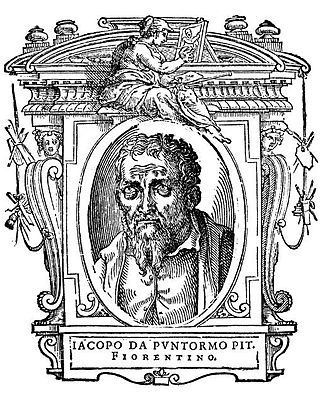
Jacopo Carucci or Carrucci, usually known as Jacopo (da) Pontormo or simply Pontormo, was an Italian Mannerist painter and portraitist from the Florentine School. His work represents a profound stylistic shift from the calm perspectival regularity that characterized the art of the Florentine Renaissance. He is famous for his use of twining poses, coupled with ambiguous perspective; his figures often seem to float in an uncertain environment, unhampered by the forces of gravity.

Irises is one of several paintings of irises by the Dutch artist Vincent van Gogh, and one of a series of paintings he made at the Saint Paul-de-Mausole asylum in Saint-Rémy-de-Provence, France, in the last year before his death in 1890.

Domenico di Pace Beccafumi was an Italian Renaissance-Mannerist painter active predominantly in Siena. He is considered one of the last undiluted representatives of the Sienese school of painting.
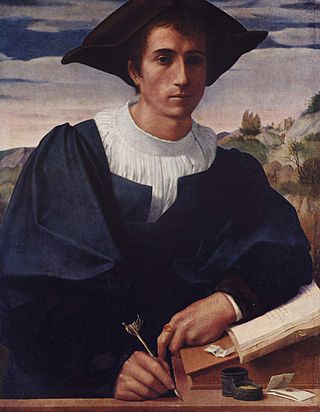
Franciabigio was an Italian painter of the Florentine Renaissance. His true name may have been Francesco di Cristofano; he is also referred to as either Marcantonio Franciabigio or Francia Bigio.

The J. Paul Getty Museum, commonly referred to as the Getty, is an art museum in Los Angeles, California housed on two campuses: the Getty Center and Getty Villa. It is operated by the J. Paul Getty Trust, the world's wealthiest art institution.

Agnolo di Cosimo, usually known as Bronzino or Agnolo Bronzino, was an Italian Mannerist painter from Florence. His sobriquet, Bronzino, may refer to his relatively dark skin or reddish hair.
John Brewster Jr. was a prolific, Deaf itinerant painter who produced many charming portraits of well-off New England families, especially their children. He lived much of the latter half of his life in Buxton, Maine, USA, recording the faces of much of Maine's elite society of his time.

Francesco Salviati or Francesco de' Rossi was an Italian Mannerist painter who lived and worked in Florence, with periods in Bologna and Venice, ending with a long period in Rome, where he died. He is known by various names, usually the adopted one of Francesco Salviati or Il Salviati, after an early patron, but also Francesco Rossi and Cecchino del Salviati.

Francesco d'Ubertino Verdi, called Bachiacca. He is also known as Francesco Ubertini, il Bacchiacca (1494–1557). He was an Italian painter of the Renaissance whose work is characteristic of the Florentine Mannerist style.

Pier Francesco Foschi (1502–1567) was an Italian painter active in Florence in a Mannerist style. He was pupil of Andrea del Sarto and assisted Pontormo with his frescoes at Careggi in 1536. He completed 3 altarpieces, commissioned in 1540–1545 for the church of Santo Spirito in Florence: an Immaculate Conception, Resurrection, and a Transfiguration. Foschi was also influenced by Il Bronzino. One of his pupils was Alessandro Fei.

The Deposition of Christ is a painting by the Italian artist Agnolo di Cosimo, known as Bronzino, completed in 1545. It is housed in the Musée des Beaux-Arts de Besançon, France. A copy by Bronzino can be found in the Palazzo Vecchio. This portrayal of the Deposition, although it depicts all the characters typically shown when Jesus is being taken down from the cross, more correctly should be characterized as a Lamentation and is an excellent example of late Mannerism or Maniera.
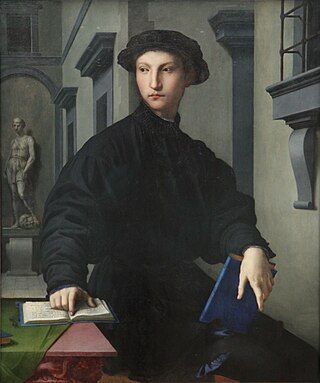
The Portrait of Ugolino Martelli is a painting by the Italian artist Agnolo di Cosimo, known as Bronzino, executed in 1536 or 1537. It is housed in the Gemäldegalerie, Berlin, Germany. The work is signed BRONZO FIORENTINO on the edge of the table top.
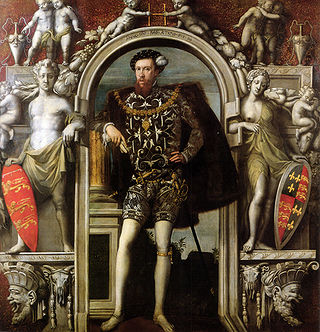
WilliamScrots was a painter of the Tudor court and an exponent of the Mannerist style of painting in the Netherlands.

The Getty Center, in Los Angeles, California, is a campus of the Getty Museum and other programs of the Getty Trust. The $1.3 billion center opened to the public on December 16, 1997, and is well known for its architecture, gardens, and views overlooking Los Angeles. The center sits atop a hill connected to a visitors' parking garage at the bottom of the hill by a three-car, cable-pulled hovertrain people mover.
Thomas Agnew & Sons is a fine arts dealer in London that began as a print and publishing partnership between Thomas Agnew and Vittore Zanetti in Manchester in 1817. Agnew ended the partnership by taking full control of the company in 1835. The firm opened its London gallery in 1860, where it soon established itself as a leading art dealership in Mayfair. Since then, Agnew's has held a pre-eminent position in the world of Old Master paintings. It also had a major role in the massive growth of a market for contemporary British art in the late 19th century. Agnew's closed in 2013. The brand name was sold privately and the gallery is now run by Lord Anthony Crichton-Stuart, a former head of Christie's Old Master paintings department, New York.
Marjorie Elizabeth Cropper is a British-born art historian with a special interest in Italian and French Renaissance and Baroque art and art literature. Dean of the National Gallery of Art’s Center for Advanced Study in the Visual Arts (CASVA) since December 2000, she previously held positions as Professor of Art History at Johns Hopkins University and director of the university’s Charles S. Singleton Center for Italian Studies at Villa Spelman in Florence.

Venus and Cupid is an oil painting on panel of c. 1533 by Pontormo, from a lost drawing or cartoon by Michelangelo, in the Galleria dell'Accademia in Florence. A preparatory study is in the British Museum and a copy by Michele di Ridolfo del Ghirlandaio is in the Palazzo Colonna in Rome. Other copies are in the Royal Collection at Kensington Palace, in Hildesheim, a small version in Geneva attributed to Michele Tosini and two in the Museo di Capodimonte in Naples. Giorgio Vasari made three copies for Ottaviano de' Medici.
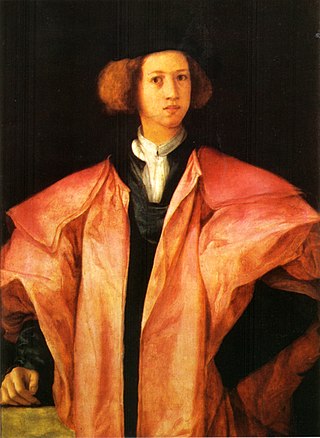
Portrait of a Young Man is an oil on panel painting by Pontormo, executed c. 1525–1526, now in the Palazzo Mansi in Lucca. It may show Alessandro de' Medici, Duke of Florence.
George R. Goldner is an American curator in charge of the Metropolitan Museum of Art's Department of Drawings and Prints from 1993 to 2015. He previously was J. Paul Getty Museum's curator of drawings and paintings from 1983 to 1993.
















